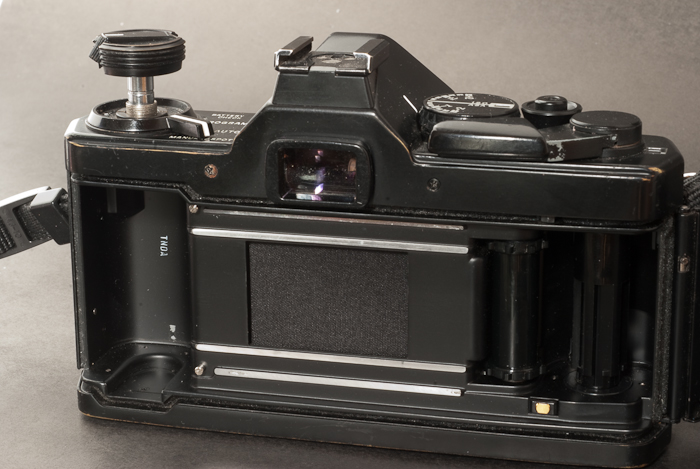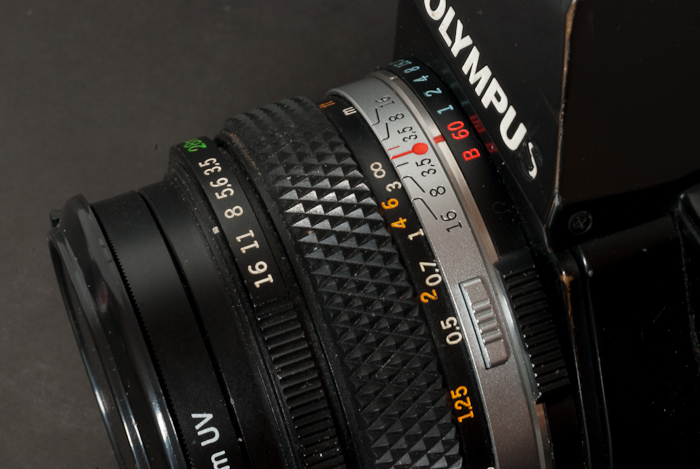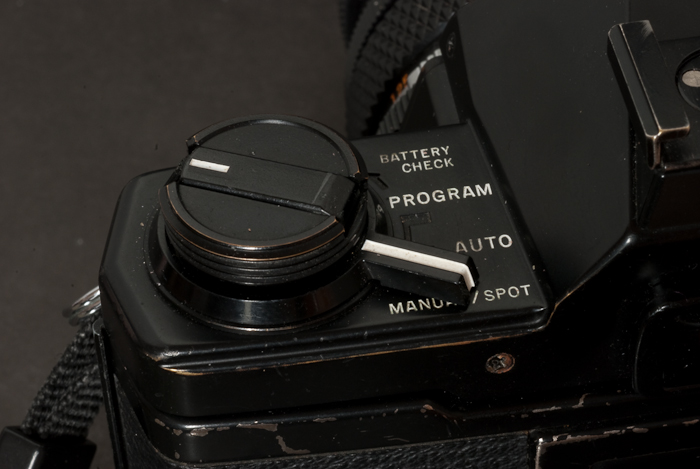
Look at the picture at the left – showing side by side the OM-2 (produced from 1975 to 1984) and its short lived successor, the OM-2s (also known as the OM-2 Spot/Program or OM-2s/p in other parts of the world), which soldiered from 1984 to 1986. They look so similar.
During the same period, Canon went from the huge EF body to the AE-1 and finally launched the first SLR with a computer inspired interface, the T70 of 1984. Minolta evolved from the XE-7 to the XG before it changed the world of SLRs forever with the first successful autofocus SLR, the 7000. And the always conservative Nikon went from the massive Nikkormat EL to the compact Nikon FE2, which integrated most of the advances of the OM-2, and coupled them with a very fast aluminum shutter.
It is true that the OM series had a significant technological advance when it was launched. But by the end of the seventies the competition had more than caught up, taking advantage of miniaturized integrated circuits and micro-processors to offer compact and feature rich cameras. Olympus was slow to adapt to the micro-processor revolution, and had to face a lot of teething problems in the process.
The early years
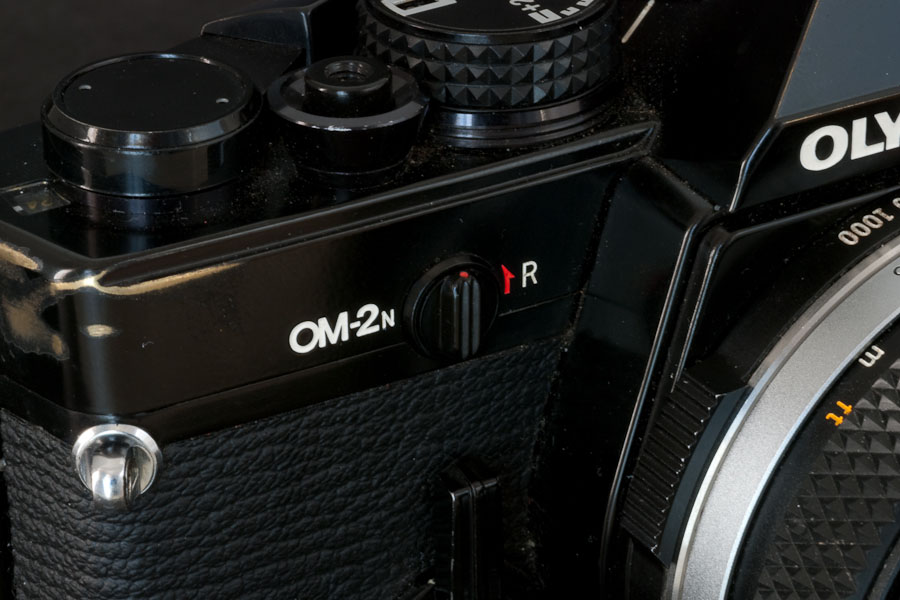

The OM-2 came a few years after the OM-1. The OM-1 had changed the world of SLRs by offering pro-level features in an incredibly compact body. The OM-2 was the automatic exposure declination of the OM-1. Interestingly, it still integrated the whole semi-auto exposure metering system of the OM-1 (with its two CdS sensors located in the prism housing), but in automatic exposure mode, it relied on blue silicon sensors located at the bottom of the reflex chamber, under the reflex mirror. Here was the true revolution: the silicon sensors measured the light reflected by the curtains of the textile shutter (and by the surface of the film) during the exposure itself. The capabilities of the camera in low light scenes are still unsurpassed, and with a compatible flash gun, the camera could control the duration of the flash exposure while the picture was being taken. Within a few years, all major competitors had adopted a similar system on a least a few of their models. In 1979, Olympus launched the OM-2n, a relatively minor update of the OM-2.
An attempt to catch up

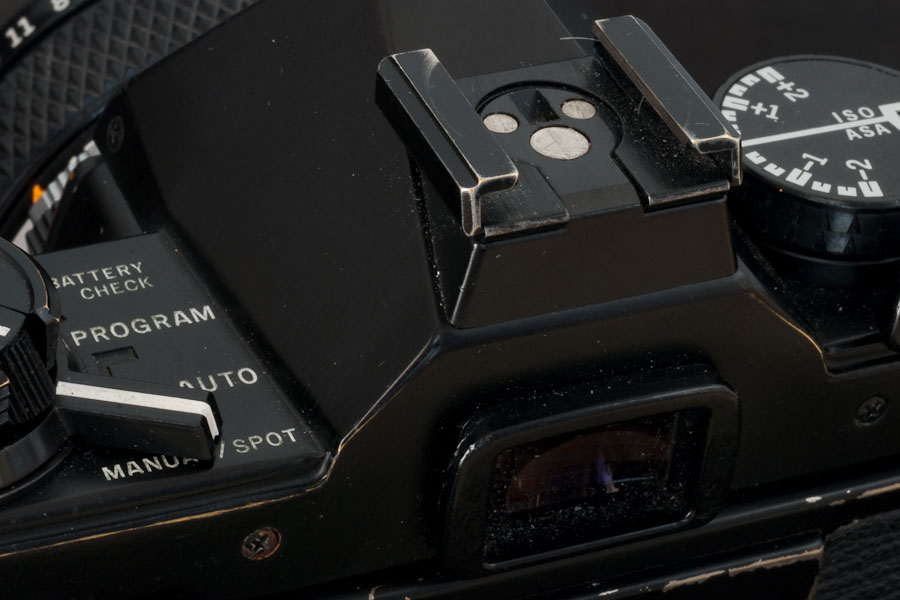
The OM-2s is not an evolution of the OM-2n. In fact it’s a spec’d down version of the OM-4, which was launched in 1984 as the true successor of the original OM-2 series.
Inside a body which looks very similar, the OM-2s is much more modern than the OM-2n. On the OM-2 and OM-2n, the silicon light metering system, being located under the reflex mirror, did not receive any light when the mirror was in its usual (low) position, and could only be used during the exposure, if the camera was set in auto exposure mode. That’s the reason why the CdS metering system of the OM-1 had also been retained: not only to support the semi-auto mode, but also to provide an indication of the shutter speed that may be set by the automatic exposure circuits when the camera was set in aperture priority mode.
The architecture of the OM-2s is different. It introduces a second (and smaller) mirror under the main (now semi-transparent) reflex mirror, which redirects 20% of the light to the silicon sensor: there is no need for a separate circuitry for the semi-auto mode anymore. The Olympus engineers took advantage of their new setup to offer multiple exposure metering patterns: when configured as an aperture priority auto camera, the OM-2s uses a weighted average pattern, and, very logically, switches to spot metering when set in semi-auto exposure mode.
There are other differences between the OM-2 and the OM-2s. Two of them are of particular interest: the match needle in the viewfinder is replaced by a vertical LCD panel at the left of the viewfinder, which can be lit by a small lamp when the user presses a button on the right of the reflex chamber, and the absence of the “off” position on the big switch on the left of the top plate. The use of LCDs has no adverse impact on the ergonomics, and whether the photographer will prefer the LCD or the OM-2s to the needle of the OM-2 is primarily a question of taste.
The absence of an “off” position on the main switch is more of an issue: even if the photographer sets the speed ring on “B”, the OM-2s is never be completely off, and it needs new batteries regularly (every few months) even if the camera is not used. The situation is made even worse by a design fault in the circuit controlling the flash, which causes the battery of the body to be rapidly drained if a cobra flash is left in the flash mount. The LR-44 (1.5v Silver Oxide) batteries ued by the OM-2s are still easy to find and relatively inexpensive, but the poor management of the batteries was and still is a major issue for the occasional users, and it explains why this model is not as eagerly sought after as its siblings.
Using an OM-2 camera
In everyday use, there is very little difference between the OM-2n and the OM-2s. The ergonomics is almost identical, the viewfinders are very similar, and both cameras can be used alternatively on a photo shoot without any inconvenience. Both share the same qualities – small size, great ergonomics, large viewfinder, good perceived quality – and the same limitations – primarily the textile shutter, limited to 1/1000 sec, with a maximum flash synchro speed of 1/60. The performance of the shutter was in line with what the competition had to offer when the original OM-2 was launched, but in 1984 Nikon proposed much better with the FE2 and the FA, and the OM-2s was outclassed.
I used both cameras recently; I did not perform any scientific testing and my opinion is just based on my limited experience with a few rolls of film. I tend to trust the metering system of the OM-2s a bit more than the OM-2n’s, and the OM-2s is the camera I will chose if I can not bring both with me. I will just have to be sure that I always have a set of fresh batteries in my equipment bag.
More about the OM-2 family of cameras
Olympus is proud of its past, and presents the history of its cameras in its global Web site.
While not as detailed as the pages dedicated to Nikon cameras, Leo Foo’s “Photography in Malaysia” Web site still provides interesting information about the Olympus OM-2.
A long list of pages dedicated to the Olympus OM cameras is maintained by Wim Wiskerke. It is worth checking.
CamerAgX already published a blog entry covering the family of the Olympus OM bodies, and one about the differences between matrix metering and the multi-spot system of the Olympus OM-4.


